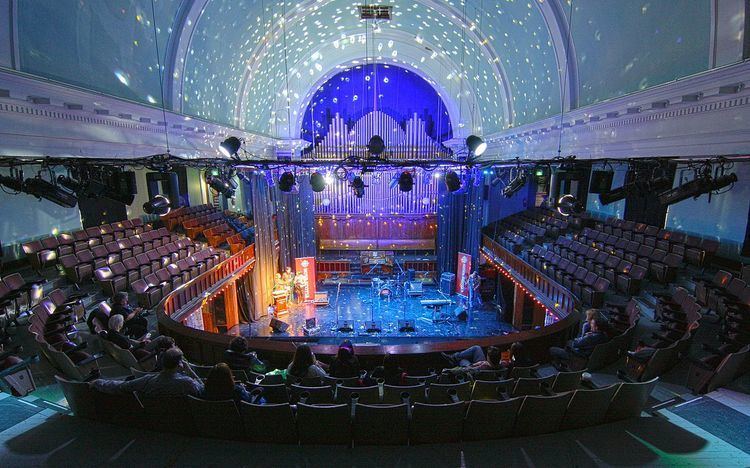Years active 1911 (1911)–present Origin Sydney, Canada | ||
 | ||
Website www.highlandartstheatre.com Genres Classical music, Folk music, Popular music, Contemporary worship music | ||
Casavant Frères Ltée. Opus 1841 is a pipe organ built by the famous Casavant Frères of Saint-Hyacinthe, Quebec. The organ was first completed in 1911 as Casavant Brothers - Opus 452 for St. Andrew's Presbyterian Church at 40 Bentinck Street, Sydney, Nova Scotia, Canada. St. Andrew's later became St. Andrew's United Church and is now the Highland Arts Theatre.
Contents
Opus 1841 is presently composed of 33 speaking stops spread over three manuals and pedals. The 2,045 pipe organ is the largest such instrument on Cape Breton Island. Its facade, casing, pipes, swell and chorus boxes completely fill the apse of the theatre.
History
Opus 1841 was purchased for the new church, then under construction, in 1911 for $5,395. The original specification was for three manuals, 4 divisions, 29 stops, 27 registers, 29 ranks, 1843 pipes. A Stoplist for the 1911 instrument copied from the factory specifications for Casavant Opus 452 1911 3/29, courtesy of the Casavant Frères Archives, St. Hyacinthe, Québec, Canada is available by following this link: Original Stoplist
The organ was rebuilt, including electrification, in 1946 by Casavant Frères Ltée. as Opus 1841, at a cost of $7,600.00. Work included three new Choir stops, a new traditional style console with roll top, three manuals, 4 divisions, 33 stops, 30 registers, 32 ranks, 2045 pipes. Manual compass is 61 notes, pedal compass is 32 notes. Equipped with electro-pneumatic (EP) chests, drawknobs in vertical rows on angled jambs, balanced swell shoes/pedals at standard AGO placement, adjustable combination pistons, AGO Standard (concave radiating) pedalboard, reversible full organ/tutti toe stud, combination action thumb pistons, combination action toe studs, coupler reversible thumb pistons, coupler reversible toe studs.
In 1962 further work was undertaken, the Clarion 4’ replaced the Vox Humana, the Trompette 8’ replaced the Cornopean, & the Hooded Harmonic Trumpet replaced an earlier Trumpet on the Great Organ, with tonal changes (new pipework supplied) made by Casavant via Ledoux & MacDonald Organ Service Co., Halifax. Wind is supplied by a 3 hp electric blower located in the basement directly below the organ.
The 18-ton organ underwent $15,000 in repairs to its bellows in 2008, with the sheep skin seams being replaced by rubberized bellows cloth. The repairs were undertaken by Maritime Pipe Organ Builders Ltd. of Moncton, New Brunswick. The tubular chimes in the Swell Organ, now disconnected, were donated in about 1929 by the Lady’s Aid group of the Church. They were activated by an electro-pneumatic action and were dis-connected from the wind supply during repairs to the bellows.
In February of 2017 Organ Tuner Jean-François Mailhot of Sydney Mines spent a week refurbishing Opus 1841, revoicing the reed stops (cleaning the reed tongues and shallots) of the swell organ: the 8' Trompette, the 8' Oboe, and the 4' Clarion, as well as the 16' Trombone of the Pedal Organ. At this time he also repaired a damaged facade pipe, part of the 8' Open Diapason stop of the Great Organ.
Basic specification
Stoplist since 1962 tonal work
Organists
Other organists over the years were:
He was succeeded by:
Concerts
While still serving as a church, St. Andrew's was considered to be perhaps the finest concert venue in the city of Sydney. Before its rebirth as an arts centre, the building had a distinguished background as a performance space. St. Andrew's Choir presented many cantatas over the years and massed choirs from eight of Sydney's churches assembled in St. Andrew's to sing as individual choirs and as a group the new and old Christmas carols. Radio broadcasts of Classical musicians regularly held recitals and concerts there over the years because of the building's outstanding acoustical properties and its Casavant Freres organ. In the mid 1950s St. Andrew's was a regular stop for one of the incarnations of the Halifax Symphony Orchestra whose performances at St. Andrew's were broadcast regionally and even nationally by CBC Radio. Thomas Mayer was the conductor. He would often invite local performers to join them, at the time there were several operatic sopranos and mezzo-sopranos from Cape Breton who gained a national following because of these broadcasts. More recently, due to its seating capacity of over 1,000, and excellent acoustics it was sought after by organizations such as Celtic Colours, The Barra MacNeils, and the Cape Breton Chorale.
